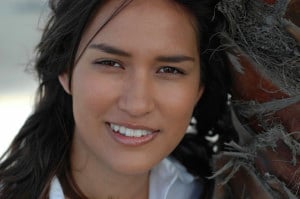I’ve written previously about the challenges I face while exercising as a kind of curvy lady.
I’ve shared with you all that it can be really tough to exercise in a world that assumes that exercise for women is for weight loss only – and for a kind of fat lady, there is no space for an alternative narrative.
That’s fucked up.
And I think a lot of you Everyday Feminists know that, too.
I received a lot of e-mails and notes after publishing that article, asking how exactly I came to a place where I could feel confident and comfortable building an exercise routine out of self-love instead of body shame.
How exactly did that process unfold for me? How exactly did that shame and fear become smaller, and how exactly did my self-loving attitude grow?
And I get the sense that folks want a five-step program for gaining the capacity for loving self care in the form of exercise at any size. Wouldn’t that be great? I mean, I would love that, too!
But unfortunately, it’s not that simple. It’s a process, and processes take time. And work. And love and intention and everything else that makes anything worthwhile.
Because being able to do anything – anything, including exercise – out of self-love is so, so worthwhile.
I don’t have a simple five-step program. But I do have some tools to share with you about my particular journey from exercising out of shame to exercising out of self-love.
Keep in mind that this set of tools is what worked for me – and it worked for me largely because exercise is something that I wanted to engage in, not something that I felt like I should do.
The truth is that we’re all fed really toxic messages about how we should exercise. For women, it’s to lose weight. For men, it’s to become more muscular. For trans or non-binary folks, it’s to fit more simply into this unfair and unrealistic binary.
And the last thing I would ever want is to tell someone what they should do – especially with their body.
But if the journey from exercising out of self-hatred to exercising out of self-love is something that interests you, you may find these tools useful.
1. I Accepted My Body As It Is
This one was the hardest and the most elusive piece of my journey. Accepting my body exactly how it is has always seemed impossible.
The truth is that before this cognitive and emotional shift, I had always accepted my body for its potential: I might not have perfectly toned arms now, but I could some day, and that’s pretty good.
This acceptance of a future self made exercise really, really miserable for me. I became goal-oriented in a way that shifted my focus and appreciation from the movement of my body in the moment and into a space of only waiting to see the results.
But it’s so important to live our lives as our own process unfolds, and that’s true for exercising, too.
When I accept my body as it is – when I accept that my stomach is soft and that my thighs touch and that my cheeks are chubby – it means giving up exercise as a tool for weight loss or body change, and focusing instead of what exercise can do for the body and mind that are perfectly mine.
I no longer think to myself, “Sarah, if you can run this last mile, maybe you can buy your next pair of jeans in a size smaller.”
Yes, I love to see results from my exercise. But the process has been about changing the way I define those results.
It’s no longer that I might lose weight or that I may become stronger; the result now means that I am proud of the movement I engaged in, that I completed something that was hard and that I feel pride in my accomplishment.
The truth is, though, that it’s really, really hard for me to accept my body sometimes.
Some days I can really lovingly embrace my body: “Fuck yeah, I live in a vessel that can carry me from one place to another and that can keep me safe from illness.”
But other days – and what used to be most days – I have a slightly more pessimistic stance: “Well, this body is mine so I guess I have no choice but to figure out how to live in it peacefully.”
For me, the process of coming to accept my body was not entirely rainbows and magic. It was hard. And inconsistent. And I still struggle. And I bet you do or will, too. And that’s okay.
Any change in thought or behavior is a process. Sit with it, notice it. Allow it to unfold.
2. I Bought Exercise Clothes That Fit Really, Really Well
Okay, people with fuller bodies, you know what I’m talking about.
Yoga pants that fold down at the waist in your first downward dog. Running pants with lousy elastic that means you’re running with one hand holding up your pants. Athletic tank tops that have an attached bra that can only be thought of as a waste of fabric and is effectively useless.
It seemed to me that exercise clothes were working against my ability and desire to exercise.
Who wants to exercise in clothes that don’t fit? In clothes that don’t stay snug in place through a full range of movement? And that’s if – and a big if – a line of athletic wear even comes in your size.
I don’t know about you, but when I work out, I work out hard. And I struggled to feel good about it while I wore ill-fitting clothes.
But actually, there’s a whole community of athletic clothes makers who understand the needs of bigger bodies in movement and who make clothes that will keep us comfortable and supported.
I love my Lineage Wear leggings for their ability to stay snugly around my waist as I move. My Fractal9 shorts don’t ride up or fall down when I exercise in the heat – and honestly, they look cute as fuck on me.
These are just two examples of clothing brands that cater to people who enjoy exercising with larger bodies. There are lots of others.
Although I’m not entirely comfortable knowing that a piece of my journey involved making purchases – engaging in capitalism is a weird way to further my own self-love, right? – these purchases were worth every penny.
For me, feeling comfortable while exercising meant feeling comfortable in my clothes, as well as my skin.
3. I Became Involved in a Community That Celebrates Fitness at Any Size
Fellow larger people, it does not feel good to work out with a room full of thin people, am I right? Like, what kind of hell is that?
When I work out, I like to see a wide variety of shapes and sizes represented. I like to see the incredibly fit fat person and the winded thin person and the person who looks like they could do reps forever. I like to see the person who is brand new to yoga try to touch their toes right next to the person who is deeply meditative in a pretzel-like shape that looks impossible for me to try.
That is what I look for when I join a gym or a running club or a yoga studio. I look for the acceptance of all kinds of bodies – across all lines of gender, size, age, color.
Fitness must be for everyone who wants it – no exceptions.
And it feels good to be out paced by someone twice my size, and it feels good to high five a person who’s half my age. It feels good to be a part of something that’s welcoming and supportive and that focuses on celebrating what our bodies can do.
To that end, I’ve also become more engaged in the Instagram fitness at every size community. Jessamyn, Dana, and Whitney are just three examples of my favorite athletes who celebrate the ability of their body to move and flow and dance and thrive.
Seeing images of women whose bodies are similar to mine is inspiring and a perfect reminder that my body is worth celebrating and honoring through my preferred means of honoring and celebrating it: exercise.
4. I Noticed My Body and Began to Live Inside of It
Before I began exercising out of self-love, I did a lot to numb and dull the sensations of my body. I didn’t eat enough to deny myself of my hunger; I ate too much to dull the emptiness inside me. I ran for too long to escape my feelings, and I slept too much in attempt to limit my exposure to the body that’s mine.
None of this is healthy or useful, of course, but it’s so profoundly common. I’m sure I’m not the only one who engages in some sort of destructive behavior to minimize the experience of being alive.
Sometimes it can all be too much, you know?
Exercise is what saved me from all of that.
And the process that I engaged in to really allow exercise to pull me from a negative cycle was the work of becoming attuned with my hungers, needs, and desires – both primitive and deeply held.
I began to notice when I was hungry. I began to notice when I was tired. I began to notice when I needed to move, to stay in place, to stretch, to blink.
I engaged in almost a starting over process. These are all tasks that infants master, but that I had somehow unlearned over the course of my life.
But actually, in order to both exercise and live fully, I needed to become more in tune with my body and its needs. I needed to engage in an emotional shift: Having a body is not bad; it’s impossible to have too much body; I am allowed to take up space.
This has taught me to honor my body’s limits and possibilities when it comes to my exercise routine. I’m less prone to injury with this new frame of mind, and I’m able to encourage myself with kindness rather than shame.
I came to this with a lot of therapy, a lot of journaling, and a lot of self-reflection. And it was hard, and I’m not anywhere near finished this process yet, but embarking on this journey has been a huge part of my ability to exercise to nourish and nurture my body, rather than punish it or change it.
***
These tools were profoundly important to me as I shifted my cognitive and emotional processes around exercise and self-kindness in general.
They may be useful to you if you’re interested in exercise – but they might also be useful to you if you want to engage in any kind of self-care.
Because the truth is that we live in a world that discourages self-care, that positions self-care and its practitioners as selfish and needy, as excessive. But self-care is deeply and critically necessary. It’s at the core of our ability to survive.
And my own favorite way of saying a big fat “fuck you” to those toxic messages is by moving my big body any and every way I’d like.
What’s your favorite way to embrace your own self-care needs?
[do_widget id=”text-101″]
Sarah Ogden Trotta is a Contributing Writer for Everyday Feminism and psychotherapist at ContactLifeline, Delaware’s Rape Crisis Center. She can be reached at [email protected]. Follow her on Twitter @xsogden. Read her articles here.
Search our 3000+ articles!
Read our articles about:
Our online racial justice training
Used by hundreds of universities, non-profits, and businesses.
Click to learn more
Most Read Articles
- « Previous
- 1
- …
- 30
- 31
- 32



















